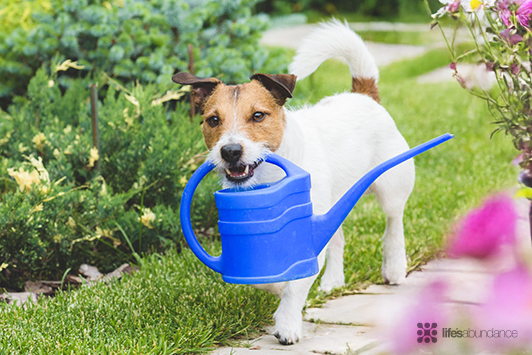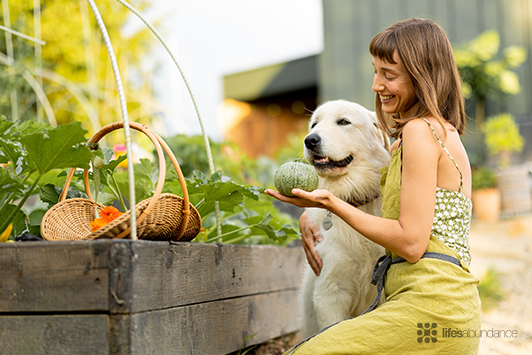
Grow a pet-friendly garden the whole family will love - furry members included!
There's something special about stepping outside, soaking up the sunshine, and getting your hands in the dirt. Gardening offers the perfect mix of peace and purpose—from the colors of your favorite blooms to the anticipation of harvesting fresh greens. And if you're like us, you're just itching to dig in and put that green thumb to work.
Before we sink our garden trowels into the dirt, we need to take our pets' safety into consideration. Gardening presents several challenges we must navigate to ensure our furry friends stay happy and safe.
These challenges include choosing pet-safe plants, designing a space that keeps both pets and plants protected, and making sure your garden is a safe and enjoyable retreat for the whole family - furry members included!
A little planning goes a long way in creating a space that's safe, beautiful, and pet-approved. Bust out your best straw hat, grab your garden gloves and let's start designing a pet-friendly paradise.
Toxic Plants for Pets and What to Plant Instead
Not all greenery is pet-friendly. The last thing any gardener wants is their curious pup or kitty nibbling on something harmful. Some plants can cause mild tummy aches, while others can be downright dangerous.
But don't worry - creating a safe and beautiful garden is easier than you think! Simply swapping out hazardous greenery for plants safe for cats and dogs can keep your furry friends happy and healthy while still enjoying a lush, vibrant outdoor space.
Swap Lilies for Catnip
A springtime favorite and beloved for their stunning blooms and versatility. Despite their beauty, lilies can pose a serious danger for pet parents, particularly those with outdoor cats. All parts of the lily plant—petals, leaves, stems, and even pollen—are highly poisonous to cats and can cause kidney failure.
A pet-safe alternative? Catnip! Not only is it completely non-toxic for cats and dogs, but your feline friend will love it. This easy-to-grow herb adds a pop of green to your garden, provides natural enrichment for curious kitties, and even helps repel pests. Plus, it's low maintenance - just plant it, and let the magic happen!
Swap Tulips for Marigolds
A classic sign of spring, tulips are loved for their bright, cheerful blooms that bring a pop of color to any garden. But for pet parents, tulips come with a buried risk - the bulbs. These contain tulipalin A and B, compounds that can cause upset bellies, drooling, and nausea if pets take a bite. Dogs that love to dig are most at risk, as larger amounts can lead to increased heart rate and breathing issues.
A safer swap? Marigolds! These sunny, easy-to-grow flowers bring the same vibrant charm without the worry. Marigolds are completely pet-safe, naturally deter pests, and thrive in a variety of conditions. Their warm hues are a beautiful addition to a pet-friendly garden.
Swap Azaleas & Rhododendrons for Spiraea
Azaleas and rhododendrons are prized for their vibrant, eye-catching blooms and lush, bushy growth, making them a landscaping favorite. But despite their beauty, these shrubs contain grayanotoxins, which can be harmful to both cats and dogs. Even a small nibble on the leaves or flowers can cause drooling, vomiting, diarrhea, and weakness.
A safer alternative? Spiraea! This hardy, flowering shrub offers the same full, decorative look with clusters of pink, white, or red blooms - without the pet risks. Spiraea is easy to grow, drought-resistant, and thrives in a variety of climates, making it a great choice for pet-friendly landscapes.

A little planning leads to a thriving, pet friendly garden for all to enjoy.
More Plants to Watch Out For in a Pet-Friendly Garden
Most plants are safe for pets, but a few can cause tummy trouble or other issues if nibbled. No need to worry - just keep an eye on these when planning your garden:
- Tomato Plants – While ripe tomatoes are fine, the leaves and stems contain solanine and tomatine, which can upset tummies and cause weakness.
- Garlic – A kitchen garden favorite, but for pets, it can damage red blood cells and lead to anemia.
- Daffodils – These sunny blooms hide lycorine in their bulbs, which can cause vomiting and stomach upset if dug up and eaten.
- Sago Palm – A landscaping favorite in warm climates, but incredibly toxic—just a small bite can cause serious liver damage.
- Oleander – Beautiful but best admired from afar. Even a nibble can affect the heart and digestive system.
- Foxglove – This dramatic, towering flower may look stunning, but its toxins can interfere with heart function and digestion.
Choosing plants safe for cats and plants safe for dogs can result in a beautiful, thriving garden that's safe for the whole family - furry members included!
But plants aren't the only thing to consider - there are a few more simple steps you can take to make sure your outdoor space is both pet-friendly and plant-friendly.
Watch Your Paws! Hidden Hazards in the Garden
Making smart plant swaps is a great first step toward a pet-friendly garden, but greenery isn't the only thing to consider. From hidden hazards in the soil to everyday gardening tools, a few small precautions can go a long way in keeping your outdoor space safe for your pets. Here are a few more things to keep in mind while you're creating your dream garden!
Cocoa Mulch – It may smell rich and chocolatey, but like actual chocolate, cocoa mulch contains theobromine, which is toxic to dogs. If your pup is a curious sniffer, it's best to stick with natural wood chips or other pet-safe mulches.
Fertilizers, Pesticides & Rodent Bait – Even organic options can upset tummies, and some products contain chemicals that are dangerous if ingested. Always store these products securely and out of reach.
Compost Piles – While composting is great for the environment, moldy food scraps and decomposing materials can be harmful to pets. Keep your compost bin securely covered or fenced off to prevent unwanted snacking.
Sharp Garden Tools – Rakes, pruners, and shovels left out can pose a problem to playful pets. Store them safely when not in use to prevent accidents.
Standing Water – Stagnant water in pots, birdbaths, or garden features can attract mosquitoes and bacteria. Refresh water sources regularly to keep your garden clean and pet-friendly.
Thorny or Spiky Plants – Roses, cacti, and similar plants may look beautiful, but they can scratch noses, paws, and curious mouths. If you love these plants, consider placing them in raised beds or behind barriers to keep your pets safe.
A little awareness goes a long way in keeping your pets safe while roaming your garden. Now, let's talk about designing a garden that both you and your furry friends will love!
Building a Pet-Friendly Garden: Design Tips for a Safe & Happy Outdoor Space
A pet-friendly garden isn't just about avoiding harmful plants - it's about creating a space where both you and your furry companions can thrive. With a few thoughtful design choices, you can build a garden that's both beautiful and functional, giving your pets a safe, enriching environment to explore while protecting your plants at the same time.
Keep Plants Safe with Fencing & Raised Beds
Curious noses and playful paws can make quick work of freshly planted flowers or vegetable gardens. Using low fencing or raised garden beds helps keep your plants safe while also preventing pets from nibbling on something they shouldn't. Raised beds also make it easier for you to maintain your garden - a win-win for everyone!
Provide Shade & Fresh Water
Just like us, pets need a break from the sun! Whether it's a shady tree, a pergola, or a designated pet retreat, having cool, shady spots in your garden gives pets a place to relax on warm days. Make sure there's also a fresh water source nearby to keep them hydrated while they enjoy the outdoors. And if your dog loves to lounge while watching you tend the garden, a bully stick with our Bully Stick Holder makes for the perfect treat to keep them happily occupied.
Give Dogs Space to Run & Play
If your pup has a case of the zoomies, an open area of soft grass or pet-safe ground cover gives them a space to burn off energy without trampling delicate flowers or garden beds.
Create a Designated Digging Zone
Some dogs just love to dig, so why not give them a designated digging area? A small section filled with loose soil or sand can help redirect their instincts away from your flower beds while still giving them a fun outlet. You can even bury toys in the digging area to encourage them to use it!
Add Pathways to Guide Exploration
Dogs and cats love to patrol their territory, and a winding garden path can help keep them on track instead of trampling through flower beds. Use mulch, stepping stones, or smooth gravel to create a pet-friendly walkway that keeps paws comfortable and your garden intact.
Make Your Garden a Wildlife-Friendly Haven
Many pets love watching birds flit around the yard, so why not make your garden a welcoming space for them too? Installing bird-safe houses and baths allows your pet to enjoy the sights and sounds of nature without disturbing the local wildlife. Just be sure to place feeders and baths high enough to keep them out of reach from playful paws!
With a little planning, you can create a garden that's just as enjoyable for your pets as it is for you. From choosing the right plants to designing a safe, pet-friendly space, small adjustments can make a big difference in keeping your outdoor area beautiful and worry-free. So, grab your gardening gloves, let your pet explore, and enjoy a thriving, tail-wagging garden together!
If you found this interesting, check out these related stories:
Common Houseplants That Are Safe For Pets
Why Do Dogs Chew? How Bully Sticks Can Help